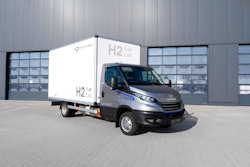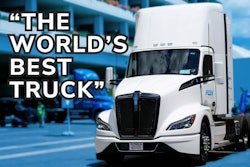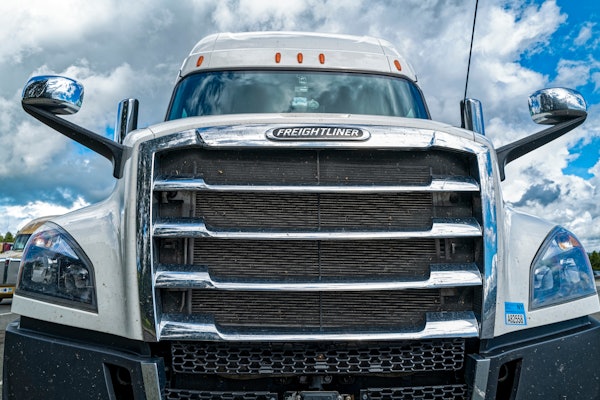
Just because an alternative form of power for heavy-duty vehicles is hailed as the next great thing to turn trucking green, doesn’t mean its halo won’t dim when more is known about how it will be manufactured and what it will take to run them in revenue service.
Do natural gas trucks ring a bell? Arguably, CNG and then LNG were the first alternative fuels held up as the solution to vault past diesel’s high levels of greenhouse gas emissions. CNG was touted as a good swap for diesel for centrally fueled and, typically, medium-duty trucks. LNG was aimed at longer-haul heavy-duty trucks due to its greater energy content, but it requires expensive cryogenic storage. To be sure, natural gas hasn’t gone away, nor has propane for that matter. But battery power has floored it into the fast lane of development and adoption by fleets.
First to hit its stride was the battery-electric vehicle (BEV). Their primary use remains powering trucks on local or regional routes that can be recharged at the end of each shift, typically overnight at a fleet depot.
As BEVs continue to gain adherents, the hydrogen fuel cell-powered electric (HFCE) truck is being developed by truck makers and EV startups with their eye on bringing them to market by 2030.
At least one HFCE model has entered full production here already, Nikola Motors’ TREV Class 8 tractor. All major North American truck makers or their parent firms have HVCE trucks in various stages of development. For example, Toyota is partnering with Peterbilt to bring to market in 2024 HFCE Class 8 trucks the OEMs piloted at the Port of Los Angeles. And earlier this year, Hyundai showed off its Xcient fuel-cell tractor planned for the U.S. market. This Class 8 model is already available in five other countries.
Showing, of course, is not selling, but new technology for commercial trucks is best rolled out smoothly, with the focus especially on making the value case to fleet buyers even as the engineering is under way.
Making the case
“Hydrogen fuel cell trucks are just starting to see real-world use and their adoption is being driven by regional or national considerations that are much bigger than what exists for trucking fleets,” points out a guidance report issued by the North American Council for Fuel Efficiency (NACFE).
BEV trucks “should be the baseline for hydrogen fuel cell electric vehicle comparisons, rather than any internal combustion engine alternative,” the report notes. As with any alternative power choice, “fleets should optimize the specifications of HFCEVs for the job they should perform while expecting that the trade cycles will lengthen.”
NACFE’s guidance sees HFCE trucks as the only feasible zero-emission solution for long-haul duty cycles in North America. But what is a “long haul” in this discussion? “There are many interpretations of long-haul,” Rick Mihelic, NACFE’s Director of Emerging Technologies told CCJ.
Anything over 400
“In the perspective of a driver's hours of service, an 11 hour drive averaging 60 mph will get you 660 miles per driver's shift,” he said. “In practice, anything over 600 miles is really good for a day's driving. Typical driver days may see only six hours of actual driving on-highway, so perhaps 350 to 400 miles. Team drivers can obviously do more per day, but as a starting point definition for long-haul, anything over 400 miles would be considered long haul.”
Mihelic said the other key elements of defining long haul are that “the driver does not generally return to base frequently, if ever, and the weight being hauled. “Heavy long-haul points to loads that are at the higher end of freight weight expectations, where the loaded trucks are above 65,000 lbs. gross vehicle weight. Depending on what region, they can get up to as much as 142,000 lbs. GVW.”
Oak Ridge National Laboratories (ORNL), a research arm of the Department of Energy, considers hydrogen fuel cell electric power to be “an important consideration for long-haul trucks that have weight-penalty policies. Hydrogen fuel cells contain a higher amount of energy-per-unit mass than a lithium battery or diesel fuel. A truck can have a higher amount of energy available without significantly increasing the weight.”
“Vehicles that regularly go long distances with heavy payloads (over 550 miles per shift and over 65,000 lbs. GVW) need a lot of on-board energy packaged as compactly as possible so as not to make the tare weight of the truck too heavy or the vehicle length too long,” remarked Mihelic. “Hydrogen fuel cells with liquid hydrogen are likely the only viable zero emission solution that does both for the upper end of the long-haul definition.”
An example of an HFCE truck spec’ed to fit this long-haul duty cycle is the Nikola TREV. According to the company, the heavy-duty cabover will have a range of up to 500 miles and an estimated fueling time of approximately 20 minutes, akin to filling up on diesel.
Triple threat
Right now, the sticking point in all this isn’t engineering fuel cells or vehicles, regardless of the state of development of various OEMs. It’s bringing down the manufacturing production, fuel processing/transportation, and fueling station costs for fuel cell trucks. “Savings are needed across all three areas to get the [HFCE] cost down to something commercially viable,” Mihelic advises.
ORNL is one of five national laboratories charged with working together to support fuel cell adoption by the heavy-duty vehicle market while meeting the efficiency, durability, and cost requirements of the trucking industry. Fueled by $50 million in funding, the research team has set a goal to demonstrate by 2030 systems that have a one-million mile lifetime in long-haul trucking service.
Researchers there have laid out key differences between designing hydrogen fuel cells for light-duty vehicles vs. heavy-duty ones. The challenges of this chasm in application requirements, per ANL chemist Deborah Myers, center on heavy-duty vehicles requiring “a higher cell voltage to achieve optimal efficiency in addition to a three- to five-times longer required lifetime compared to light-duty vehicles, placing greater demands on the performance and durability of the fuel cell materials.”
ORNL views solutions to that demand resting on materials research that “explores how existing fuel-cell component materials operate and degrade under different temperature and humidity levels and at higher cell voltages, and development that examine how the integration of new materials can meet these challenges.”
Big bottleneck
Even with all application requirements determined, for HFCE trucks to get where they need to go will mean cracking a sizable operational bottleneck: the dearth of refueling infrastructure.
The availability of hydrogen as a vehicle fuel is low compared to the ubiquity of gasoline, a fact reflected in the number of stations that dispense the low-emission fuel. While California has more than 10,000 gasoline stations, the Hydrogen Fuel Cell Partnership counts just 59 retail hydrogen stations across the state.
Consultants with McKinsey & Company point out in an article the challenges to be met before hydrogen refueling infrastructure can reach scale: “there is limited perspective on the cost development for hydrogen trucking overall and for infrastructure specifically.”
On top of that, the “timing for ramping up infrastructure to support long-haul hydrogen trucking is not yet fully clear, and business models need to be developed to support this ramp-up. Infrastructure providers and operators also need to decide whether to concentrate on truck-focused infrastructure or to plan for dual use with passenger cars.” They also advise that liquid and gaseous hydrogen require “partly different infrastructure, resulting in competition between the two,” further muddying the timeline.
As lyricist Joe Raposo put it, “It not easy being green.” And it takes a lot of patience to go green.











